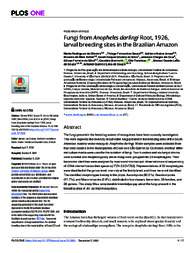Fungi from Anopheles darlingi Root, 1926, larval breeding sites in the Brazilian Amazon.
Fungi from Anopheles darlingi Root, 1926, larval breeding sites in the Brazilian Amazon.
Author(s): OLIVEIRA, M. R. de; SOUZA, T. F.; ARCOS, A. N.; KATAK, R. de M.; SILVA, S. R. S. da; CRUZ, J. C. da; SILVA, G. F. da; MARINOTTI, O.; TERENIUS, O.; SOUZA, A. D. L. de; SOUZA, A. Q. L. de
Summary: The fungi present in the aquatic habitats of mosquito larvae may provide the appropriate means to develop and implement biological control measures against malaria vectors [21–23], however, few mosquito-fungi interactions have been characterized. Therefore, this study aimed to explore the diversity of cultivable fungi present in the aquatic habitats of Anopheles darlingi larvae in two malaria-endemic municipalities in the state of Amazonas, and to fill a considerable gap in knowledge of the fungi present in the breeding sites of this important malaria vector.
Publication year: 2024
Types of publication: Journal article
Unit: Embrapa Western Amazon
Keywords: Anopheles darlingi, Fungi
Observation
Some of Embrapa's publications are published as ePub files. To read them, use or download one of the following free software options to your computer or mobile device. Android: Google Play Books; IOS: iBooks; Windows and Linux: Calibre.
Access other publications
Access the Agricultural Research Database (BDPA) to consult Embrapa's full library collection and records.
Visit Embrapa Bookstore to purchase books and other publications sold by Embrapa.

